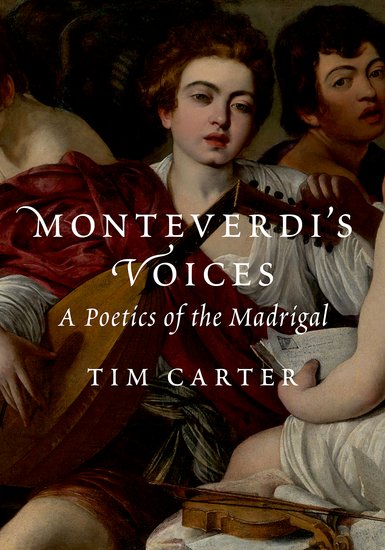 Welcome back to Book Notes, the series that shines a light on recent book publications by music department faculty and alumni. This installment explores David G. Frey Distinguished Professor Emeritus of Music Tim Carter’s Monteverdi’s Voices: A Poetics of the Madrigal, published by Oxford University Press on June 7.
Welcome back to Book Notes, the series that shines a light on recent book publications by music department faculty and alumni. This installment explores David G. Frey Distinguished Professor Emeritus of Music Tim Carter’s Monteverdi’s Voices: A Poetics of the Madrigal, published by Oxford University Press on June 7.
Professor Carter joined the Department of Music in 2001 as the inaugural David G. Frey Distinguished Professor of Music. He served as department Chair from 2004 to 2009 and taught countless graduate and undergraduate courses until his retirement in 2021. Much was accomplished during his tenure as chair, including constructing the Kenan Music Building, launching the James and Lilian Pruett Graduate Research Fellowship, and establishing the Kenan Music Scholars Program. His research focuses on music in late Renaissance and early Baroque Italy; on Mozart’s Italian operas; and on American musical theater in the mid-twentieth century.
We recently interviewed Professor Carter about Monteverdi’s Voices, how this book intersects with his research, and the lessons he learned while writing it.
UNC Music: Give us a short synopsis of Monteverdi’s Voices.
Professor Tim Carter: Claudio Monteverdi (1567–1643) was without doubt the most significant composer working in late Renaissance and early Baroque Italy. My book offers the first comprehensive survey of the madrigals that he published in eight books between 1587 and 1638 (a ninth was issued posthumously). These are settings of Italian love-poetry (by Petrarch, Tasso, Guarini, Marino, among others), initially for five unaccompanied voices as was the norm, but increasingly—given the stylistic changes in the period—for solo voice(s) and instrumental accompaniment. Monteverdi composed almost 150 such settings throughout his long lifetime, so they allow us to see very clearly what mattered most to him at various stages in his career. I also show him working closely with the performers under his direction, first at the court of Duke Vincenzo Gonzaga of Mantua, and then when he moved to Venice to take charge of music at St. Mark’s Basilica.
 UNC Music: How does Monteverdi’s Voices fit into your overall teaching, performance, and research interests?
UNC Music: How does Monteverdi’s Voices fit into your overall teaching, performance, and research interests?
Professor Carter: I had previously published a book on Monteverdi’s Musical Theatre (New Haven and London: Yale University Press, 2002)—principally on his three surviving operas—so it made sense to move from the stage into the chamber, and into a much more intimate performing world. I have also long been interested in how Italian poetry and music might intersect in various genres and historical moments. Graduate seminars at UNC-CH very much helped me bring things into focus by way of students asking very smart questions, and helping me see music I thought I knew well through fresh eyes. Working with professional early-music ensembles on concert and recording projects also gave me different kinds of insight in terms of hearing, and feeling, these madrigals from the inside out, as it were.
UNC Music: What inspired you to write this book in particular?
Professor Carter: It had been bubbling up for a number of years as I tried different things out in journal articles and conference papers. But it was my retirement in July 2021 after forty-some years of teaching that gave me the time really to dig deep into this repertory, and at that point, things came together fairly quickly. As for the “inspiration,” it’s all Monteverdi’s fault: he really is a remarkable composer whose music has always moved me deeply, and continues to do so.
UNC Music: Were there any surprises along the journey of writing this book?
Professor Carter: The typical textbook view of Monteverdi is that he established what he called a “second practice” in contrast to the “first” (the more typical style of Renaissance music). In this seconda pratica, so Monteverdi said, the words took precedence over the music, meaning that he could break any and every musical rule if it could be justified by expressing the text. And yes, he did just that. But inevitably, music always won out in the end, and I was surprised by just how often Monteverdi felt able to distort or even alter his poetic texts if it suited some musical purpose. Being able to link these madrigals to specific performers of Monteverdi’s time was a further revelation. I was also delighted to discover far more madrigals than I ever knew before, each of which is a gem in its own right.
UNC Music: If readers could take one thing away from this book, what do you hope it would be?
Professor Carter: That Monteverdi’s madrigals are so achingly beautiful to perform and hear!
“A long-awaited probing digest of Monteverdi’s madrigals from the foremost Monteverdian scholar of our time. Tim Carter sets himself apart from the musicological fray by his sensitivity to the contextual backdrop to these all-absorbing miniatures and by treating them as essentially performative acts. He has fascinating things to reveal about the different ways Monteverdi plays with sonic space and (most innovatively) with time. Never blind to Monteverdi’s occasional errors and quirks, Carter focuses on the intriguing interface between poetry and music: he lifts the lid on how Monteverdi responded to the poetry he was setting, how he enriched and enlivened it, and occasionally contradicted it. Most of all he shows how it became the launchpad for flights of musical fantasy previously unimaginable.” -Sir John Eliot Gardiner
Monteverdi’s Voices: A Poetics of the Madrigal can be purchased from Oxford University Press, Amazon, or your local bookseller.
